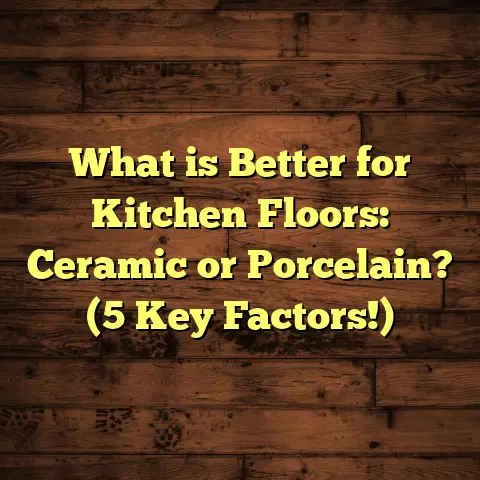What is a General Term for Floor Coverings? (5 Types You Need)
Craftsmanship is an art. Over the years, I’ve seen how the right choice of flooring can change a room’s entire personality. When I lay down a new floor, it’s not just about slapping materials onto a surface—it’s about creating a foundation that supports daily life and reflects the people who live there. Flooring tells a story, and I’ve had the privilege of helping countless homeowners write theirs.
You might not realize it, but when you use the term “flooring,” you’re referring to a broad category that covers many types of floor coverings. But what exactly does “floor covering” mean? And which types should you really know about? Let me walk you through this with details, tips, and stories from my own experience.
What Is a General Term for Floor Coverings?
When people ask me, “What’s the general term for floor coverings?” I always say it’s simply “flooring.” Flooring is the finished surface on top of your subfloor that you walk on every day. It’s what gives your room character and comfort.
Flooring includes everything from plush carpet to hard tile, vinyl sheets to hardwood planks. It’s a broad term that covers many materials designed to protect the subfloor and provide a functional, attractive surface.
In my early days as a contractor, clients often got confused by all the jargon—“laminate,” “engineered wood,” “tile,” “vinyl plank,” and so on. I realized breaking down these categories makes it easier to decide what fits their needs and budgets.
Focusing on five main types helps most homeowners understand what’s available without being overwhelmed:
- Hardwood Flooring
- Vinyl Flooring
- Carpet
- Tile (Ceramic & Porcelain)
- Laminate Flooring
These five cover most residential and commercial projects I encounter.
1. Hardwood Flooring: The Classic Choice
Hardwood flooring is timeless. I’ve worked with oak, maple, walnut, and many other species over the years. There’s something special about the natural grain patterns in hardwood that synthetic floors can’t replicate.
What Makes Hardwood Special?
Hardwood floors come from solid wood planks milled from trees. They offer:
- Durability: Properly installed hardwood can last over 50 years.
- Aesthetic Appeal: The natural grain and color variations add warmth and elegance.
- Refinishing Ability: You can sand and refinish hardwood multiple times, which extends its lifespan.
Personal Experience
I did a project for a couple renovating their 1920s home. The original hardwood was hidden beneath layers of carpet and linoleum. After careful sanding and refinishing, the floors revealed their original beauty—rich honey tones and unique grain patterns. It gave the entire house a sense of history and charm that new materials couldn’t match.
Practical Tips
- Moisture Sensitivity: Hardwood expands and contracts with humidity changes. Avoid installing it in bathrooms or basements.
- Maintenance: Regular sweeping and occasional refinishing keep hardwood looking great.
- Installation: Nail-down or glue-down installation requires a flat subfloor.
Cost Insights
Hardwood flooring installation typically costs between $6 and $12 per square foot, including materials and labor. Exotic woods or custom finishes push prices higher.
2. Vinyl Flooring: Affordable Versatility
Vinyl flooring has evolved drastically from its early days as a cheap option. Now, vinyl planks and tiles can mimic wood, stone, or ceramic with impressive realism.
Why Vinyl Works Well
Vinyl is made from synthetic materials like PVC. It’s:
- Water-resistant: Good for kitchens, laundry rooms, and basements.
- Durable: Resistant to scratches and dents.
- Affordable: Generally costs less than hardwood or tile.
- Low Maintenance: Easy to clean with just sweeping and mopping.
My Vinyl Installations
I installed vinyl plank flooring in an Airbnb rental unit in a coastal area prone to humidity. The vinyl handled moisture without warping or peeling, unlike previous hardwood floors there. The client appreciated the lower cost and ease of care.
Installation Notes
Vinyl can be glued down or installed as floating floors with click-lock edges—great for DIY projects.
Costs
Expect to pay $2 to $7 per square foot installed, depending on quality and style.
3. Carpet: Comfort Underfoot
Carpet is all about coziness and warmth. Growing up, my family had wall-to-wall carpet in most rooms, which made winter mornings bearable in our cold climate.
What Carpet Offers
- Softness: Provides cushioning underfoot.
- Thermal Insulation: Helps retain heat.
- Sound Absorption: Reduces noise in busy households.
- Variety: From plush to Berber, nylon to wool.
Things to Watch For
Carpets trap dust and allergens, so regular vacuuming is key for allergy sufferers.
Story Time
Once, I helped install carpet in a daycare center where kids run around all day. We chose a durable nylon carpet with stain-resistant treatment—it held up well even after spills and heavy wear.
Costs
Carpet installation ranges from $3 to $7 per square foot depending on fiber type and quality.
4. Tile: Durability Meets Design
Tile flooring—especially ceramic and porcelain—is a staple in wet or heavily used areas like bathrooms and kitchens.
Ceramic vs Porcelain
- Ceramic: Made from clay fired at lower temperatures; less dense.
- Porcelain: Fired hotter; denser; better water resistance.
Porcelain is my go-to for areas that face moisture daily because it doesn’t absorb water easily.
Design Flexibility
Tiles come in countless sizes, colors, textures, and patterns—from simple white squares to intricate mosaics.
A Memorable Tile Project
I worked on a kitchen remodel where we used large-format porcelain tiles with subtle veining to imitate marble. The client wanted luxury look without fragile marble maintenance—and we achieved exactly that.
Installation & Maintenance Tips
Tile requires grout sealing to prevent stains. It’s durable but can crack if laid over an uneven subfloor.
Costs
Tile installation varies widely but commonly runs $7 to $15 per square foot installed.
5. Laminate Flooring: The Budget-Friendly Lookalike
Laminate flooring uses a composite wood base with a photographic layer on top that mimics wood or stone surfaces.
Why Laminate Is Popular
- Cost-efficiency: Cheaper than hardwood or tile.
- Scratch Resistance: Good for homes with pets.
- DIY-Friendly Installation: Click-lock planks float over subfloor.
- Low Maintenance: No waxing or polishing needed.
Experience With Laminate
I recall a young couple who wanted the look of hardwood but couldn’t afford it yet. We installed laminate in their living room and hallway—easy for them to do themselves with some guidance—and it looked fantastic at a fraction of the price.
Things to Consider
Laminate doesn’t handle water well—spills should be cleaned quickly to avoid damage.
Cost Range
Laminate flooring usually costs between $1 and $5 per square foot installed.
How I Use Technology Like FloorTally to Simplify Flooring Projects
Budgeting for flooring can be tricky—estimating material quantities, labor costs, waste factors—it adds up fast. That’s where tools like FloorTally come into play for me.
With FloorTally, I input room dimensions, choose flooring types, and get instant cost estimates based on local rates for both materials and labor. It also factors in waste percentages automatically—that little extra that accounts for cutting errors or damaged planks.
Using this tool has saved me hours of back-and-forth with suppliers and clients trying to nail down budgets. It helps keep projects on track financially without surprises later on.
If you’re planning flooring work yourself or hiring pros, having clear cost estimates early on can make all the difference.
More Tips From My Years On The Job
- Always Inspect Your Subfloor First
Uneven or damaged subfloors can cause problems like squeaking floors or cracked tiles later on. - Match Flooring With Room Use
High-moisture areas need waterproof options like tile or vinyl; bedrooms benefit from softer surfaces like carpet or hardwood. - Consider Longevity vs Budget
Sometimes spending more upfront saves you money long-term if materials last longer or require less maintenance. - Don’t Forget Underlayment
For laminate or vinyl floors especially, underlayment can improve sound insulation and floor comfort. - Plan For Waste Material
Adding 5-10% extra when ordering material prevents delays if you need additional pieces during installation.
Data & Statistics That Shed Light On Flooring Choices
- According to recent industry reports, approximately 35% of residential flooring installations use hardwood or engineered wood.
- Vinyl flooring accounts for about 25%, favored for its affordability.
- Carpet represents roughly 20% of installations in colder climates where warmth is prized.
- Tile is chosen in 15% of cases due to durability requirements.
- Laminate captures about 5% of the market as an economical alternative with quick installation benefits.
Knowing these numbers helps me advise clients realistically based on what others are choosing in similar circumstances.
Case Study: A Whole-House Flooring Project That Made A Difference
A few years ago, I worked on a large family home where each room had different needs:
- Living Room: We installed red oak hardwood for warmth and longevity.
- Kitchen & Mudroom: Porcelain tiles were used for moisture resistance.
- Bedrooms: Carpets went in for comfort and noise reduction.
- Basement: Luxury vinyl planks handled occasional dampness well.
- Hallways: Laminate flooring balanced durability with budget constraints.
The family was thrilled that each space had flooring suited perfectly to use without compromising style or comfort. This project took careful planning but proved how mixing floor coverings wisely works beautifully.
Final Thoughts From My Toolbox
Flooring forms a big part of what makes a house feel like home. When you understand that “flooring” covers such diverse materials, you’re better prepared to choose what fits your lifestyle, budget, and design taste.
From solid hardwood’s classic appeal to vinyl’s modern practicality, carpet’s warmth, tile’s durability, or laminate’s affordability—there’s something for everyone out there.
If you’re wondering which one might be right for your project or have questions about installation techniques or care routines, just ask! After years of hands-on work in this trade, I’m happy to share practical advice tailored to your situation.
And remember—a little planning goes a long way toward floors that don’t just look good but stand the test of time.





